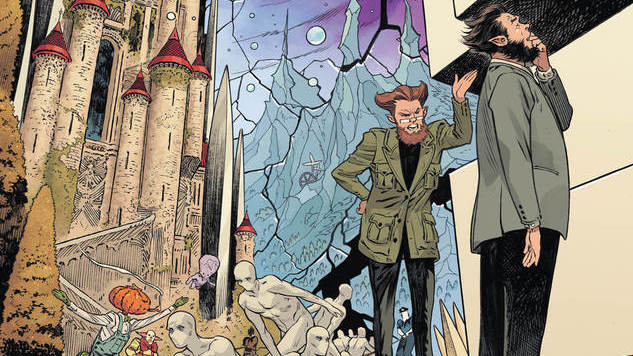Return to The Dreaming with Simon Spurrier & Bilquis Evely
The Vertigo Collaborators Discuss the Flagship Series in Neil Gaiman's Sandman Universe
Main Art by Bilquis Evely & Mat Lopes
Earlier this year, in celebration of the beloved Vertigo imprint’s 25th anniversary, DC Comics revealed The Sandman Universe, a continuation of Neil Gaiman’s mythology overseen by Gaiman himself and written and drawn by a host of fresh talent. Last month’s same-named The Sandman Universe #1 introduced each series: Books of Magic, House of Whispers, Lucifer and The Dreaming, which hits comic stands this Wednesday. The Dreaming, written by Simon Spurrier, drawn by Bilquis Evely, colored by Mat Lopes and lettered by Simon Bowland, is the most direct continuation of The Sandman out of the four; in the prelude one-shot, we discover that a book is missing from The Dreaming’s infinite library, and that Dream has seemingly decided to vacate his throne without any warning to his realm’s inhabitants. Things only get more dire in The Dreaming #1, where we catch up with dedicated librarian Lucien, lovable curmudgeon Merv Pumpkinhead, faithful raven Matthew and new characters like Dora as they adjust to a Dreaming that’s beginning to crack and crumble around them. In advance of the stunningly executed first issue, Paste exchanged emails with Evely and a phone call with Spurrier to find out more about their collaboration, the responsibility of entering Dream’s domain and whether or not their own dreams and nightmares will make their way into the series.
![]()

The Dreaming #1 Main Cover Art by Jae Lee
Paste: Vertigo comics, and Sandman in particular, are often cited as major gateway comics for readers who may be less invested in capes-and-tights superheroics. Did Morpheus or any other Vertigo icons make a mark on your comic education growing up and entering the industry?
Evely: It’s funny, because I started reading comics with superheroes books, and it’s not even my favorite genre. I mean, I loved it, but after this initial debut as a reader, my background in comic books became more alternative—like when I read Julia, an Italian comic book from Bonelli Editore. But Vertigo is still new to me in some ways, including Sandman, which I read after I was invited to the project. It’s a crime that I hadn’t read it before, I know.
Paste: The amount of worldbuilding the creative team is doing on this book is, frankly, staggering. What’s your design process for The Dreaming? Do you work most of it out on the page or have you been hunkering down for months designing realms and creatures and characters?
Evely: I started my studies for the series one month before I got the first script. But honestly, it wasn’t that hard. For some reason, I felt completely comfortable. I just needed to create a base, a logic to build up the realm rich with crazy things. But, at the end of the day, if I respect the iconic foundations and specific characteristics of the Sandman atmosphere, I can do literally anything. It’s a dream. It’s changeable and malleable.
For the characters, the process was a bit different. Based on all the artists of The Sandman, I have an amalgamation of ideas of how all the classic characters should look. I know them—all the mannerisms, expressions, postures—and then I just needed to add my own style.

The Dreaming #1 Interior Art by Bilquis Evely & Mat Lopes
Paste: What’s your collaboration like with Mat Lopes and Simon Bowland? How much do you weigh in on Mat’s choices and Simon’s placement, and how has this working relationship affected your own approach to the line art?
Evely: Mat and I are good friends, so we discuss the pages, the scenes and the characters all the time. I give him suggestions and vice-versa. I think that’s why our work together looks so homogeneous. But, at the same time, working together as a team is new, so we’re still learning what works better with each other’s art. Which means that what was good before is now getting even better! We always say, “I’m proud of our work. Yeah, we’re very proud of our work.”
As always with Sandman, there’s a lot of text, which can be tricky to manage sometimes as an artist. Respecting the storytelling and layout, I try to create compositions with “open” camera angles and space. Not dead space, but space to let the scene “breathe,” and that’s where Simon does his magic.
Paste: Without digging too deeply into process talk, what kind of approach do you use these days? Are you purely physical, all digital or a hybrid of the two?
Evely: I always draw the thumbnails digitally, because it’s easier to edit and revise. Otherwise, all my process is traditional with pencil and brush.

The Dreaming #1 Interior Art by Bilquis Evely & Mat Lopes
-

-

-

-

-

-

-

-

-

-

-

-

-

-

-

-

-

-

-

-

-

-

-

-

-

-

-

-

-

-

-

-

-

-

-

-

-

-

-

-











































